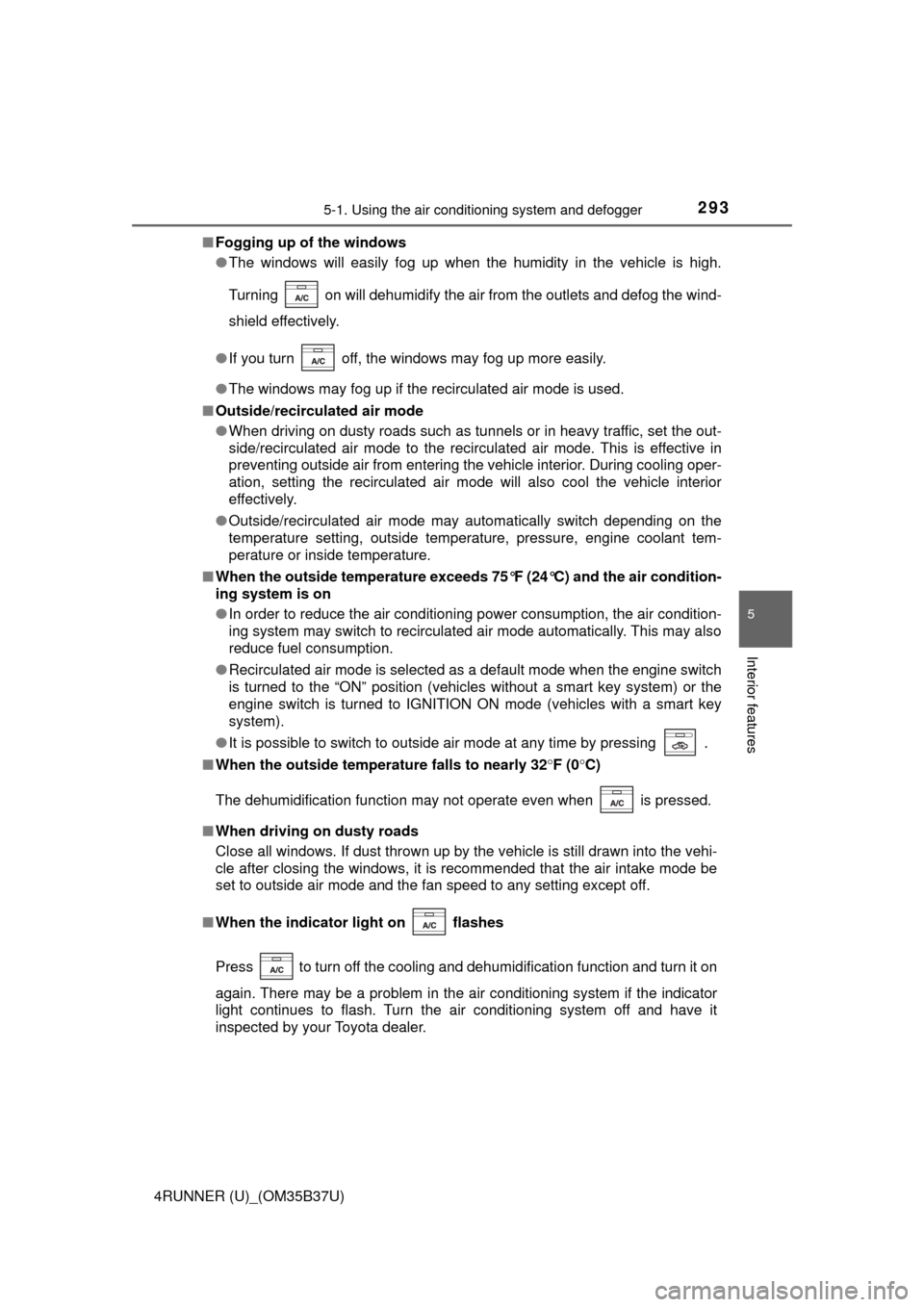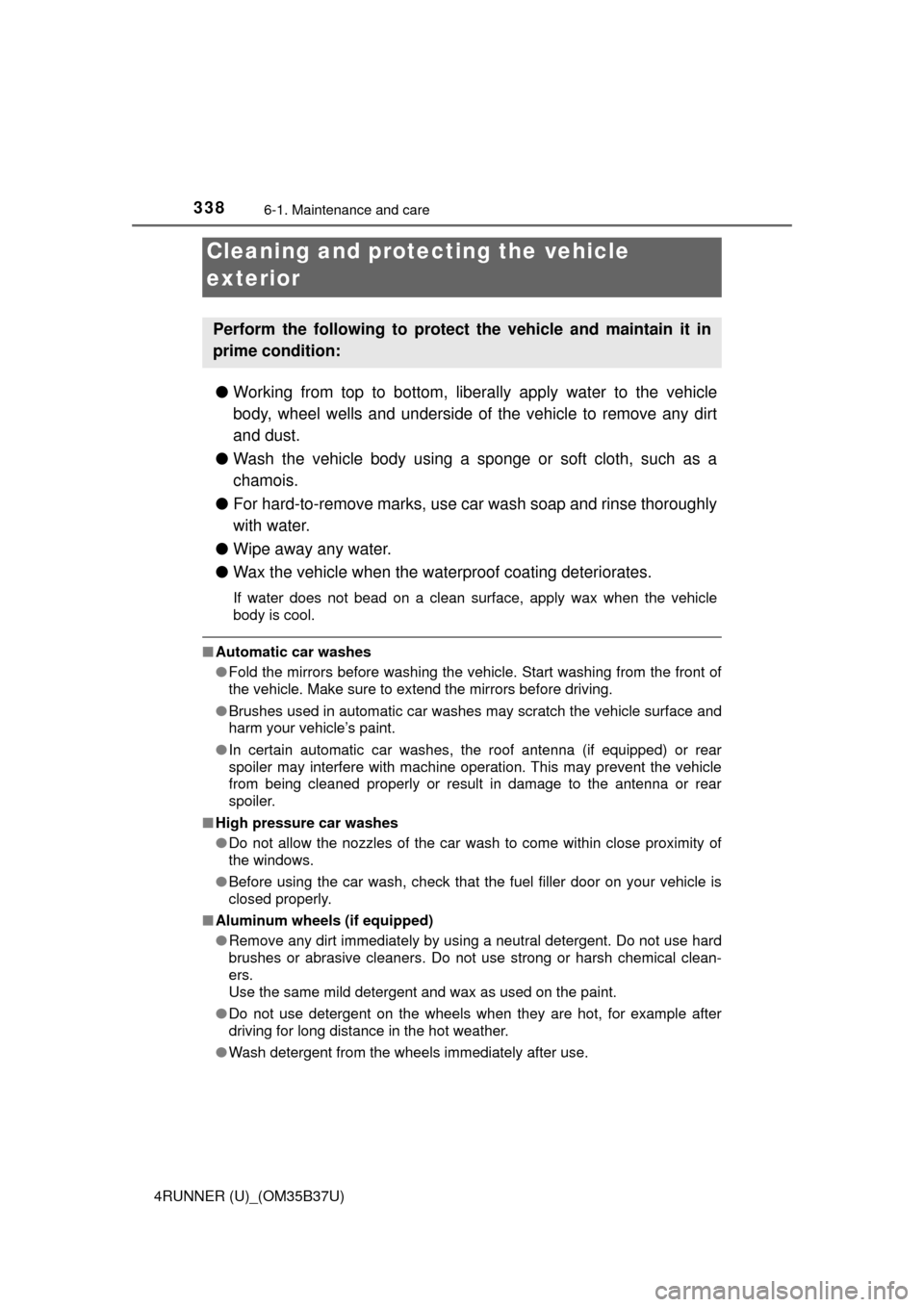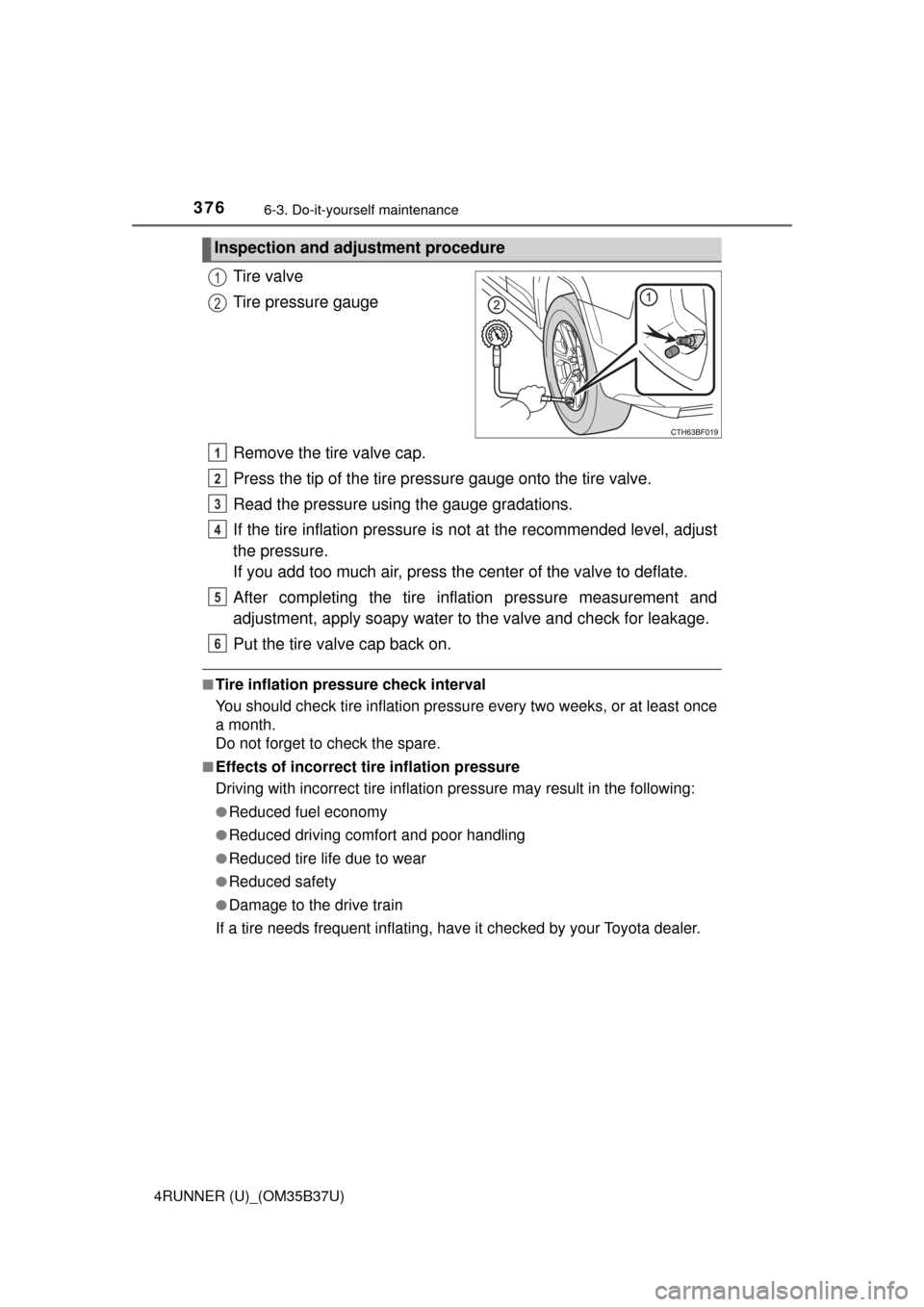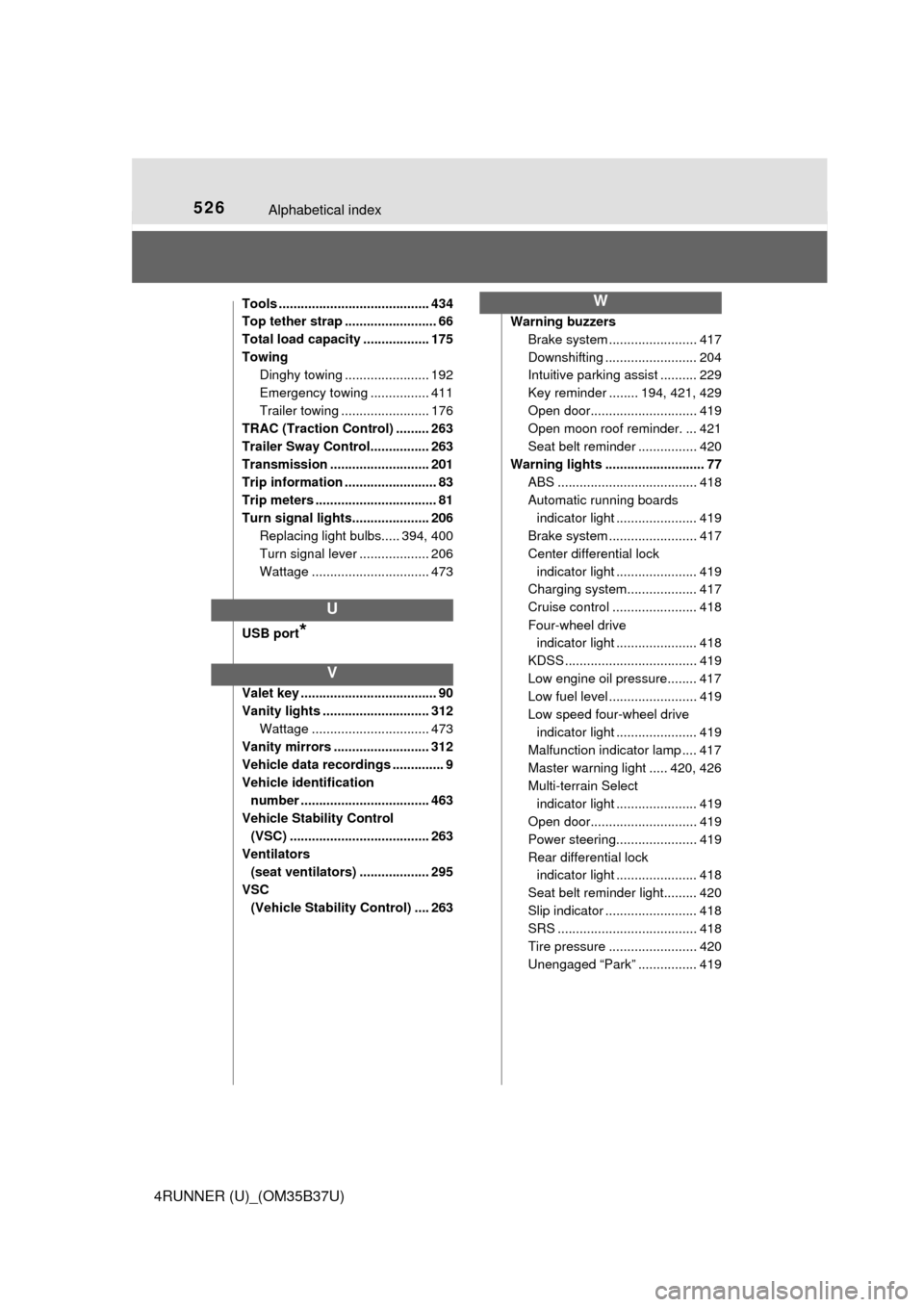2017 TOYOTA 4RUNNER fuel pressure
[x] Cancel search: fuel pressurePage 5 of 528

5
1
8 7
6
5
4
3
2
9
4RUNNER (U)_(OM35B37U)6-1. Maintenance and care
Cleaning and protecting the vehicle exterior .......... 338
Cleaning and protecting the vehicle interior ........... 341
6-2. Maintenance Maintenance requirements ................... 344
General maintenance ........ 346
Emission inspection and maintenance (I/M)
programs ......................... 349
6-3. Do-it-yourself maintenance
Do-it-yourself service precautions ..................... 350
Hood.................................. 353
Engine compartment ......... 354
Tires .................................. 369
Tire inflation pressure........ 375
Wheels .............................. 378
Air conditioning filter .......... 381
Wireless remote control/ electronic key
battery ............................. 383
Checking and replacing fuses ............................... 386
Light bulbs ......................... 389 7-1. Essential information
Emergency flashers ........... 406
If your vehicle has to be stopped in an
emergency....................... 407
7-2. Steps to take in an emergency
If your vehicle needs to be towed .......................... 409
If you think something is wrong............................... 415
Fuel pump shut off system ............................. 416
If a warning light turns on or a warning buzzer
sounds ............................. 417
If a warning message or indicator is displayed ....... 426
If you have a flat tire .......... 433
If the engine will not start ................................. 448
If you cannot operate back door opener ............ 450
If the electronic key does not operate properly ........ 451
If the vehicle battery is discharged ....................... 453
If your vehicle overheats.... 457
If the vehicle becomes stuck ................................ 460
6Maintenance and care7When trouble arises
Page 78 of 528

782. Instrument cluster
4RUNNER (U)_(OM35B37U)
*1: These lights turn on when the engine switch is turned to IGNITION ONmode (vehicles with a smart key system) or the engine switch is turned to
the “ON” position (vehicles without a smart key system) to indicate that a
system check is being performed. They will turn off after the engine is
started, or after a few seconds. There may be a malfunction in a system if
the lights do not come on, or do not turn off. Have the vehicle inspected by
your Toyota dealer.
*2: The light flashes to indicate a malfunction.
*3: The light flashes rapidly to indicate a malfunction.
*4: The light flashes continuously to indicate a malfunction.
Open door warning light
(→P. 419)*1Master warning light
(→P. 426)
Low fuel level warning
light ( →P. 419)*1Tire pressure warning
light (→P. 420)
Seat belt reminder light
(→P. 420)
(if equipped)
Unengaged “Park” warn-
ing light ( →P. 419)
*1
Low engine oil pressure
warning light ( →P. 417)*1
(if equipped)
KDSS warning light
(→P. 419)
*1
Power steering warning
light ( →P. 419)*1, 2
(if equipped)
Automatic running
boards indicator light
(→P. 419)
Page 293 of 528

2935-1. Using the air conditioning system and defogger
5
Interior features
4RUNNER (U)_(OM35B37U)■
Fogging up of the windows
●The windows will easily fog up when the humidity in the vehicle is high.
Turning on will dehumidify the air from the outlets and defog the wind-
shield effectively.
● If you turn off, the windows may fog up more easily.
● The windows may fog up if the recirculated air mode is used.
■ Outside/recirculated air mode
●When driving on dusty roads such as tunnels or in heavy traffic, set the out-
side/recirculated air mode to the recirculated air mode. This is effective in
preventing outside air from entering the vehicle interior. During cooling oper-
ation, setting the recirculated air mode will also cool the vehicle interior
effectively.
● Outside/recirculated air mode may automatically switch depending on the
temperature setting, outside temperature, pressure, engine coolant tem-
perature or inside temperature.
■ When the outside temperature exceeds 75°F (24°C) and the air condition-
ing system is on
● In order to reduce the air conditioning power consumption, the air condition-
ing system may switch to recirculated air mode automatically. This may also
reduce fuel consumption.
● Recirculated air mode is selected as a default mode when the engine switch
is turned to the “ON” position (vehicles without a smart key system) or the
engine switch is turned to IGNITION ON mode (vehicles with a smart key
system).
● It is possible to switch to outside air mode at any time by pressing
.
■When the outside temperat ure falls to nearly 32°F (0°C)
The dehumidification function may not operate even when is pressed.
■ When driving on dusty roads
Close all windows. If dust thrown up by the vehicle is still drawn into the vehi-
cle after closing the windows, it is recommended that the air intake mode be
set to outside air mode and the fan speed to any setting except off.
■ When the indicator light on flashes
Press
to turn off the cooling and dehumidification function and turn it on
again. There may be a problem in the air conditioning system if the indicator
light continues to flash. Turn the air conditioning system off and have it
inspected by your Toyota dealer.
Page 338 of 528

338
4RUNNER (U)_(OM35B37U)
6-1. Maintenance and care
●Working from top to bottom, liber ally apply water to the vehicle
body, wheel wells and underside of the vehicle to remove any dirt
and dust.
● Wash the vehicle body using a sponge or soft cloth, such as a
chamois.
● For hard-to-remove marks, use car wash soap and rinse thoroughly
with water.
● Wipe away any water.
● Wax the vehicle when the wate rproof coating deteriorates.
If water does not bead on a clean surface, apply wax when the vehicle
body is cool.
■Automatic car washes
●Fold the mirrors before washing the vehicle. Start washing from the fron\
t of
the vehicle. Make sure to extend the mirrors before driving.
● Brushes used in automatic car washes may scratch the vehicle surface and
harm your vehicle’s paint.
● In certain automatic car washes, the roof antenna (if equipped) or rear
spoiler may interfere with machine operation. This may prevent the vehicle
from being cleaned properly or result in damage to the antenna or rear
spoiler.
■ High pressure car washes
●Do not allow the nozzles of the car wash to come within close proximity of
the windows.
● Before using the car wash, check that the fuel filler door on your vehicle is
closed properly.
■ Aluminum wheels (if equipped)
●Remove any dirt immediately by using a neutral detergent. Do not use hard
brushes or abrasive cleaners. Do not use strong or harsh chemical clean-
ers.
Use the same mild detergent and wax as used on the paint.
● Do not use detergent on the wheels when they are hot, for example after
driving for long distance in the hot weather.
● Wash detergent from the wheels immediately after use.
Cleaning and prot ecting the vehicle
exterior
Perform the following to protect the vehicle and maintain it in
prime condition:
Page 376 of 528

3766-3. Do-it-yourself maintenance
4RUNNER (U)_(OM35B37U)
Tire valve
Tire pressure gauge
Remove the tire valve cap.
Press the tip of the tire pressure gauge onto the tire valve.
Read the pressure usi ng the gauge gradations.
If the tire inflation pressure is not at the recommended level, adjust
the pressure.
If you add too much air, press the center of the valve to deflate.
After completing the tire inflation pressure measurement and
adjustment, apply soapy water to the valve and check for leakage.
Put the tire valve cap back on.
■Tire inflation pressure check interval
You should check tire inflation pressure every two weeks, or at least once
a month.
Do not forget to check the spare.
■Effects of incorrect tire inflation pressure
Driving with incorrect tire inflation pressure may result in the following:
●Reduced fuel economy
●Reduced driving comfort and poor handling
●Reduced tire life due to wear
●Reduced safety
●Damage to the drive train
If a tire needs frequent inflating, have it checked by your Toyota dealer.
Inspection and adjustment procedure
1
2
1
2
3
4
5
6
Page 424 of 528

4247-2. Steps to take in an emergency
4RUNNER (U)_(OM35B37U)
CAUTION
■If the tire pressure warning light comes on
Be sure to observe the following precautions. Failure to do so could
cause a loss of vehicle control and result in death or serious injury.
●Stop your vehicle in a safe place as soon as possible. Adjust the tire
inflation pressure immediately.
●If the tire pressure warning light comes on even after tire inflation pres-
sure adjustment, it is probable that you have a flat tire. Check the tires.
If a tire is flat, change it with the spare tire and have the flat tire
repaired by the nearest Toyota dealer.
●Avoid abrupt maneuvering and braking. If the vehicle tires deteriorate,
you could lose control of the steering wheel or the brakes.
■If a blowout or sudden air leakage should occur
The tire pressure warning system may not activate immediately.
■Maintenance of the tires
Each tire, including the spare (if provided), should be checked monthly
when cold and inflated to the inflation pressure recommended by the
vehicle manufacturer on the vehicle placard or tire inflation pressure
label (tire and load information label) . (If your vehicle has tires of a dif-
ferent size than the size indicated on the vehicle placard or tire inflation
pressure label [tire and load information label], you should determine
the proper tire inflation pressure for those tires.)
As an added safety feature, your vehicle has been equipped with a tire
pressure monitoring system (TPMS-ti re pressure warning system) that
illuminates a low tire pre ssure telltale (tire pressure warning light) when
one or more of your tires is significantly under-inflated. Accordingly,
when the low tire pressure telltale (tire pressure warning light) illumi-
nates, you should stop and check your tires as soon as possible, and
inflate them to the proper pressure. Driving on a significantly under-
inflated tire causes the tire to overheat and can lead to tire failure.
Under-inflation also reduces fuel effi ciency and tire tread life, and may
affect the vehicle’s hand ling and stopping ability.
Please note that the TPMS (tire pressure warning system) is not a sub-
stitute for proper ti re maintenance, and it is the driver’s responsibility to
maintain correct tire pressure, even if under-inflation has not reached
the level to trigger illumination of the TPMS low tire pressure telltale (tire
pressure warning light).
Page 483 of 528

4838-1. Specifications
8
Vehicle specifications
4RUNNER (U)_(OM35B37U)
Glossary of tire terminology
Tire related termMeaning
Cold tire inflation pres-
sure
Tire pressure when the vehicle has been
parked for three hours or more, or has not
been driven more than 1 mile or 1.5 km under
that condition
Maximum inflation
pressureThe maximum cold inflated pressure to which
a tire may be inflated, shown on the sidewall
of the tire
Recommended infla-
tion pressureCold tire inflation pressure recommended by a
manufacturer
Accessory weight
The combined weight (in excess of those stan-
dard items which may be replaced) of auto-
matic transmission, power steering, power
brakes, power windows, power seats, radio
and heater, to the extent that these items are
available as factory-installed equipment
(whether installed or not)
Curb weight
The weight of a motor vehicle with standard
equipment, including the maximum capacity of
fuel, oil and coolant, and if so equipped, air
conditioning and additional weight optional
engine
Maximum loaded vehi-
cle weight
The sum of:
(a) Curb weight
(b) Accessory weight
(c) Vehicle capacity weight
(d) Production options weight
Normal occupant
weight150 lb. (68 kg) times the number of occupants
specified in the second column of Table 1
*
that follows
Occupant distributionDistribution of occupants in a vehicle as speci-
fied in the third column of Table 1
* below
Page 526 of 528

526Alphabetical index
4RUNNER (U)_(OM35B37U)
Tools ......................................... 434
Top tether strap ......................... 66
Total load capacity .................. 175
TowingDinghy towing ....................... 192
Emergency towing ................ 411
Trailer towing ........................ 176
TRAC (Traction Control) ......... 263
Trailer Sway Control................ 263
Transmission ........................... 201
Trip information ......................... 83
Trip meters ................................. 81
Turn signal lights..................... 206 Replacing light bulbs..... 394, 400
Turn signal lever ................... 206
Wattage ................................ 473
USB port
*
Valet key ..................................... 90
Vanity lights ............................. 312 Wattage ................................ 473
Vanity mirrors .......................... 312
Vehicle data recordings .............. 9
Vehicle identification number ................................... 463
Vehicle Stability Control (VSC) ...................................... 263
Ventilators
(seat ventilators) ................... 295
VSC (Vehicle Stabilit y Control) .... 263 Warning buzzers
Brake system ....... ................. 417
Downshifting ......................... 204
Intuitive parking assist .......... 229
Key reminder ........ 194, 421, 429
Open door............................. 419
Open moon roof reminder. ... 421
Seat belt reminder ................ 420
Warning lights ........................... 77 ABS ...................................... 418
Automatic running boards
indicator light ...................... 419
Brake system ....... ................. 417
Center differential lock indicator light ...................... 419
Charging system................... 417
Cruise control ....................... 418
Four-wheel drive indicator light ...................... 418
KDSS .................................... 419
Low engine oil pressure........ 417
Low fuel level ........................ 419
Low speed four-wheel drive indicator light ...................... 419
Malfunction indicator lamp .... 417
Master warning light ..... 420, 426
Multi-terrain Select indicator light ...................... 419
Open door............................. 419
Power steering...................... 419
Rear differential lock indicator light ...................... 418
Seat belt reminder light......... 420
Slip indicator ......................... 418
SRS ...................................... 418
Tire pressure ........................ 420
Unengaged “Park” ................ 419
U
V
W